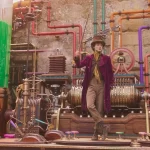All Dirt Roads Taste of Salt: Bittersweet Memory, by Scott Nye

Even the title conjures a tactile sensation, somewhere between repellent and enticing. The feature debut of poet/photographer/filmmaker Raven Jackson, All Dirt Roads Taste of Salt is at once elliptical and circular, weaving in and out of moments in at least four stages of the life of a black woman in Mississippi (played, at various points, by Mylee Shannon, Kaylee Nicole Johnson, Charleen McClure, and Zainab Jah). It is pointedly non-narrative, though not without certain throughlines, and greatly concerned with certain memory triggers – hands and touching, lips and kissing, and the elements (fire, water, naturally dirt) that surround Mack.
For those who know Tarkovsky’s Mirror, it’s an easy point of reference, just without, you know, all the overtly magical imagery. As in that, Jackson’s subjects seem to spring from the earth itself, their lives, troubles, and dreams expressed through their bodies and their environment. How much each viewer will seize onto the story will vary. I don’t mind admitting my retention and comprehension of it all was fairly low, with the note that my candor here should not be construed as a knock against the film.
It is, first off, absolutely gorgeous. Jackson and cinematographer Jomo Fray haven’t nearly the resources Tarkovsky did, but craft with them a similar sense of awe. Terrence Malick and Carlos Reygadas are two other references Jackson has noted, and like them, she can turn the perfectly ordinary into something spectacular. A scene at a kitchen sink has resonated with me in the weeks since seeing it as firmly as a house on fire. The way hands, eyes, and mouths are mirrored, echoed, and transformed across the decades is beautifully told and observed by editor Lee Chatametikool (whose contributions to Apichatpong Weerasethakul’s work provide the same sense of emotionally-coherent connections). It’s a pleasurable film to spend ninety minutes with.
And beyond its immediate pleasures, it has a real sense of intimacy, like we’re all at once getting not only a view of these people as they live, but their interior sense of being there, as well as a few truths they are not yet ready to admit to themselves. This is done with remarkably little dialogue or voiceover, just bodies, places, sounds, and images. The fundamentals. It has the sense of journeying back through one’s past and suddenly being electrified by a stray moment that seems to summarize your life anew.
All of this makes it completely distinct in a contemporary commercial space, and its muted audience (though ecstatic critical) reception at Sundance, as well as its extremely-limited release (here in Los Angeles, it will play once a day, at varying times, starting tonight at the Landmark Sunset), reflect the difficulty in releasing this. Nevertheless, for audiences that do connect with it, it will be all the more powerful for its singularity, for how firmly it stands apart from the rest of quasi-mainstream cinema (it’s being released by A24, whose reputation is about as big as an independent studio can get). I highly recommend taking the chance on it.





























